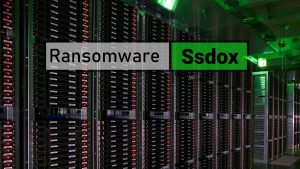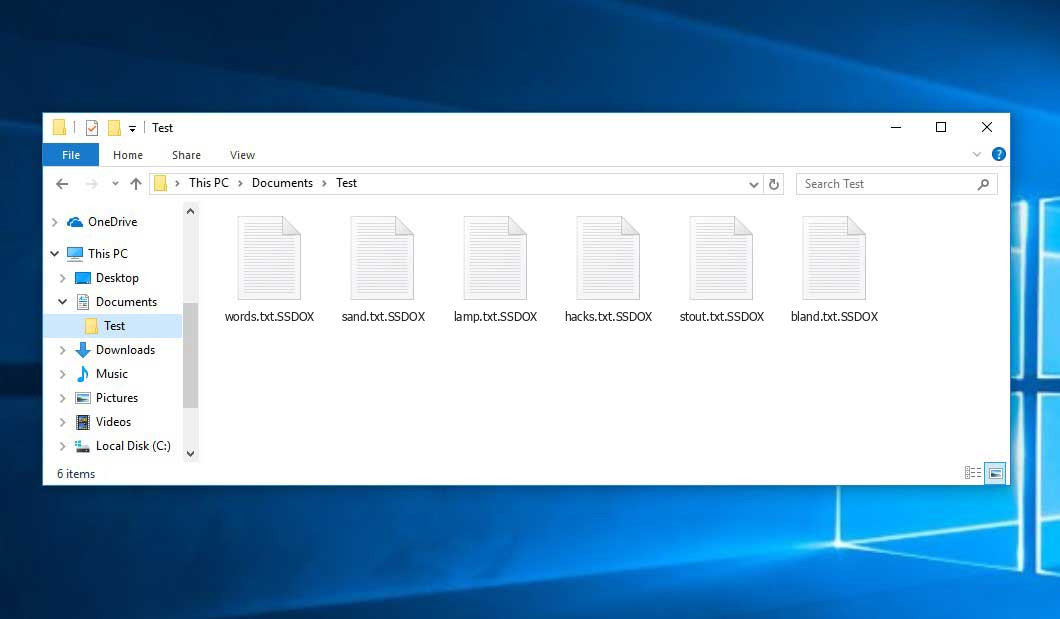The Ssdox virus falls within the CONTI ransomware family. Malware of such sort encrypts all user’s data on the PC (photos, text files, excel tables, music, videos, etc) and appends its specific extension to every file, creating the readme.txt text files in every directory with the encrypted files.
What is Ssdox?
☝️ A scientifically accurate description for the Ssdox is “a CONTI family ransomware-type infection”.
Ssdox adds its specific SSDOX to every file’s title. For instance, a file entitled “photo.jpg” will be altered to “photo.jpg.SSDOX”. Just like the Excel sheet with the name “table.xlsx” will be changed to “table.xlsx.SSDOX”, and so on.
In each directory containing the encrypted files, a readme.txt notebook document will be created. It is a ransom money note. It contains information about the ways of contacting the racketeers and some other remarks. The ransom note usually contains instructions on how to buy the decryption tool from the tamperers. That is it.
Ssdox overview:
| Name | Ssdox Virus |
| Ransomware family1 | CONTI ransomware |
| Extension | .SSDOX |
| Ransomware note | readme.txt |
| Detection | Win32/Injector.QHO, Win32/Injector.BJQP, Trojan.Win32.Fsysna.ibdg |
| Symptoms | Your files (photos, videos, documents) have a .SSDOX extension and you can’t open them. |
| Fix Tool | See If Your System Has Been Affected by Ssdox virus |
In the picture below, you can see what a folder with files encrypted by the Ssdox looks like. Each filename has the “.SSDOX” extension added to it.
How did my machine catch Ssdox ransomware?
There is a huge number of possible ways of ransomware injection.
There are currently three most exploited ways for tamperers to have ransomware working in your system. These are email spam, Trojan introduction and peer file transfer.
If you access your mailbox and see emails that look just like notifications from utility services providers, postal agencies like FedEx, web-access providers, and whatnot, but whose “from” field is unknown to you, be wary of opening those emails. They are very likely to have a ransomware file attached to them. Thus it is even riskier to download any attachments that come with emails like these.
Another thing the hackers might try is a Trojan file scheme2. A Trojan is an object that infiltrates into your PC disguised as something different. Imagine, you download an installer of some program you need or an update for some software. However, what is unpacked turns out to be a harmful program that corrupts your data. As the installation package can have any title and any icon, you’d better be sure that you can trust the resource of the things you’re downloading. The optimal thing is to trust the software developers’ official websites.
As for the peer-to-peer file transfer protocols like torrents or eMule, the threat is that they are even more trust-based than the rest of the Internet. You can never guess what you download until you get it. Our suggestion is that you use trustworthy resources. Also, it is a good idea to scan the directory containing the downloaded files with the anti-malware utility as soon as the downloading is done.
How do I get rid of the Ssdox virus?
It is important to inform you that besides encrypting your data, the Ssdox virus will probably install the Azorult Spyware on your machine to seize your credentials to different accounts (including cryptocurrency wallets). The mentioned program can extract your credentials from your browser’s auto-filling data.
Sometimes tamperers would decode several of your files to prove that they do have the decryption program. As Ssdox virus is a relatively new ransomware, security software engineers have not yet found a way to reverse its work. However, the decoding tools are constantly upgraded, so the solution may soon be available.
Understandably, if the malefactors succeed in encrypting victim’s critical data, the desperate person will most likely fulfill their demands. Nevertheless, paying to criminals gives no guarantee that you’re getting your files back. It is still risky. After obtaining the money, the racketeers may deliver a wrong decryption key to the victim. There were reports about criminals simply vanishing after getting the ransom without even writing back.
The optimal countermeasure to ransomware is to have a system restore point or the copies of your critical files in the cloud disk or at least on an external disk. Surely, that might be not enough. The most important thing could be that one you were working upon when it all happened. But at least it is something. It is also reasonable to scan your drives with the antivirus program after the system restoration.
Ssdox is not the only ransomware of its kind, since there are other specimens of ransomware out there that act in the same manner. Examples of those are Futm, Rigj, Pqgs, and some others. The two main differences between them and the Ssdox are the ransom amount and the encoding method. The rest is almost identical: files become inaccessible, their extensions altered, ransom notes appear in each directory containing encrypted files.
Some fortunate victims were able to decode the arrested files with the aid of the free tools provided by anti-ransomware developers. Sometimes the racketeers mistakenly send the decoding code to the wronged in the ransom readme. Such an epic fail allows the victim to restore the files. But of course, one should never expect such a chance. Remember, ransomware is a tamperers’ technology to pull the money out of their victims.
How to avoid ransomware infiltration?
Ssdox ransomware doesn’t have a endless power, neither does any similar malware.
You can armour your computer from ransomware injection taking several easy steps:
- Ignore any letters from unknown mailers with unknown addresses, or with content that has likely no connection to something you are waiting for (how can you win in a lottery without participating in it?). In case the email subject is likely something you are expecting, check all elements of the suspicious letter carefully. A hoax email will surely have mistakes.
- Avoid using cracked or untrusted programs. Trojans are often spreaded as an element of cracked software, possibly as a “patch” to prevent the license check. Understandably, dubious programs are very hard to distinguish from reliable software, because trojans may also have the functionality you seek. Try searching for information on this program on the anti-malware forums, but the optimal way is not to use such software.
- And finally, to be sure about the safety of the files you downloaded, check them with GridinSoft Anti-Malware. This program will be a perfect defense for your system.
Reasons why I would recommend GridinSoft3
There is no better way to recognize, remove and prevent ransomware than to use an anti-malware software from GridinSoft4.
Download Removal Tool.
You can download GridinSoft Anti-Malware by clicking the button below:
Run the setup file.
When setup file has finished downloading, double-click on the setup-antimalware-fix.exe file to install GridinSoft Anti-Malware on your system.

An User Account Control asking you about to allow GridinSoft Anti-Malware to make changes to your device. So, you should click “Yes” to continue with the installation.

Press “Install” button.

Once installed, Anti-Malware will automatically run.

Wait for the Anti-Malware scan to complete.
GridinSoft Anti-Malware will automatically start scanning your system for Ssdox infections and other malicious programs. This process can take a 20-30 minutes, so I suggest you periodically check on the status of the scan process.

Click on “Clean Now”.
When the scan has finished, you will see the list of infections that GridinSoft Anti-Malware has detected. To remove them click on the “Clean Now” button in right corner.

FAQ
🤔 How can I open “.SSDOX” files?Are the “.SSDOX” files accessible?
Unfortunately, no. You need to decipher the “.SSDOX” files first. Then you will be able to open them.
🤔 I really need to decrypt those “.SSDOX” files ASAP. How can I do that?
If the “.SSDOX” files contain some really important information, then you probably have them backed up. Otherwise, you might try to employ System Restore. The only question is whether you have saved any Restore Points that would be helpful now. There are other ways to beat ransomware, but they take time.
🤔 If GridinSoft deletes the Ssdox malware, will it also delete my files that were encrypted?
No way! Your encrypted files are no threat to your PC.
GridinSoft Anti-Malware only deals with actual threats. The malware that has attacked your system is most likely still active and running scans periodically to arrest any new files you might create on your PC after the attack. As it has been said above, the Ssdox ransomware comes with the company. It installs backdoors and keyloggers that can steal your account credentials and provide malefactors with easy access to your system in the future.
🤔 What should I do if the Ssdox virus has blocked my computer and I can’t get the activation key.
In such a case, you need to have a memory stick with a previously installed Trojan Killer. Use Safe Mode to perform the procedure. The point is that the ransomware starts automatically as the system launches and encodes any new files created or brought into your computer. To block this function – use Safe Mode, which allows only the essential programs to run upon system start. Consider reading our manual on running Windows in Safe Mode.
🤔 What could help the situation right now?
Some of the blocked files can be located elsewhere.
- If you sent or received your important files via email, you could still download them from your online mailbox.
- You might have shared photographs or videos with your friends or family members. Just ask them to give those images back to you.
- If you have initially downloaded any of your files from the Internet, you can try downloading them again.
- Your messengers, social media pages, and cloud drives might have all those files as well.
- Maybe you still have the needed files on your old computer, a portable device, mobile, external storage, etc.
HINT: You can employ file recovery utilities5 to get your lost data back since ransomware encrypts the copies of your files, deleting the authentic ones. In the video below, you can learn how to use PhotoRec for such a restoration, but be advised: you can do it only after you kill the ransomware itself with an antivirus program.
Also, you can contact the following official fraud and scam sites to report this attack:
- In the United States: On Guard Online;
- In Canada: Canadian Anti-Fraud Centre;
- In the United Kingdom: Action Fraud;
- In Australia: SCAMwatch;
- In New Zealand: Consumer Affairs Scams;
- In France: Agence nationale de la sécurité des systèmes d’information;
- In Germany: Bundesamt für Sicherheit in der Informationstechnik;
- In Ireland: An Garda Síochána;
To report the attack, you can contact local executive boards. For instance, if you live in USA, you can have a talk with FBI Local field office, IC3 or Secret Service.
I need your help to share this article.
It is your turn to help other people. I have written this article to help people like you. You can use the buttons below to share this on your favorite social media Facebook, Twitter, or Reddit.
Brendan SmithHow to Remove SSDOX Ransomware & Recover PC

Name: SSDOX Virus
Description: SSDOX Virus is a ransomware-type infections. This virus encrypts important personal files (video, photos, documents). The encrypted files can be tracked by a specific .SSDOX extension. So, you can't use them at all.
Operating System: Windows
Application Category: Virus
User Review
( votes)References
- My files are encrypted by ransomware, what should I do now?
- You can read more on Trojans, their use and types in the Trojan-dedicated section of GridinSoft official website.
- GridinSoft Anti-Malware Review from HowToFix site: https://howtofix.guide/gridinsoft-anti-malware/
- More information about GridinSoft products: https://gridinsoft.com/comparison
- Here are Best Data Recovery Software Of 2023.


